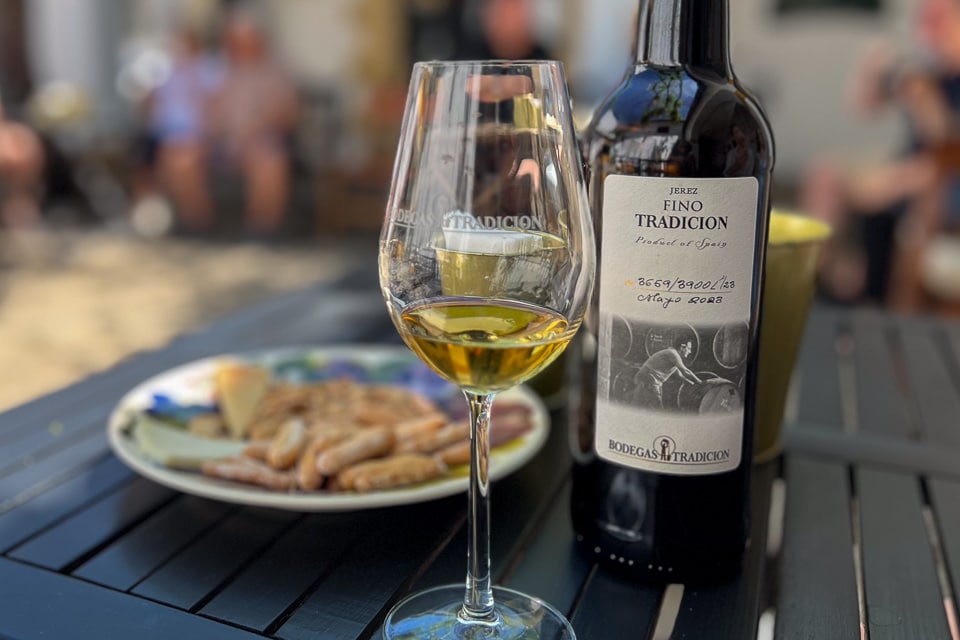
Too little time in Jerez de la Frontera. That’s our take-away after visiting this historic Spanish city in the province of Cadiz in Andalucía. With our stay of two nights, we couldn’t possibly take in all the important attractions of Jerez, but we did our best and vow to return.
The top three reasons to visit Jerez are undoubtedly for taste examples of its unique sherry production, to experience a tablao de flamenco music and dance, and to take in a horse show or visit to the Royal Andalusian School of Equestrian Art. We managed two out of three of the best things to do in Jerez. Meanwhile, we discovered why this beautiful city is a living museum and now the largest city in Cadiz province (pop. 212,000).
Jerez's location in the South of Spain explains much about its heritage and its current appeal. By today's roads, the port of Cadiz is just a 35 km (22 mile) drive from Jerez. The nearest coast, at El Puerto de Santa María, is only 6 km (3.7 miles). The trip to the Atlantic Ocean is 12 km (7.5 miles).
Table of Contents
History and Monuments
What we love about all of Andalucía is evident in within the city of Jerez de la Frontera. The melding of cultures based on various historic populations makes Jerez worth visiting. Prehistoric and ancient populations in the region eventually gave way to a Roman city called Asta Regia. But toward the Middle Ages, after the fall of the Roman Empire, this part of Spain was ruled by Visigoths until the early 8th Century. Then Moorish-ruled and independent states shifted and merged with nearby seats in Arcos de la Frontera, Sevilla, and as far away as Granada.
By the 13th Century, following the Battle of Jerez and later sieges and rebellions, Christian rule under Alfonso VII of Castile and León survived. The Muslim population remained, at least for a couple hundred years until the expulsions accomplished in 1492, and Moorish architectural influences also survived. By the way, ‘de la Frontera’, meaning on the border, is thought to reference the boundary between Moorish and Christian regions in the 13th Century.
Jerez thrived throughout the Middle Ages due to its agriculture, and prospered through the 15th and 16th Centuries – during the explorations of the Americas – due to its proximity to the ports of Cadiz and Sevilla.
The Jerez Cathedral
Guided and self-guided audio tours of the cathedral include the sacristies, main chapel, and a climb up the tower if you are up for it. You can even take a VR drone tour including dizzying aerial views. Do take the time to visit the whole cathedral, as the church’s prized possessions – like the Zurbarán painting of a dreamy ‘Virgin Nińa’ – are tucked into the sacristy, chapels and interior courtyard.
The outside view framed by flying buttresses will tell you this 17th Century Catholic church is a mix of Gothic, Baroque and Neoclassic styles.
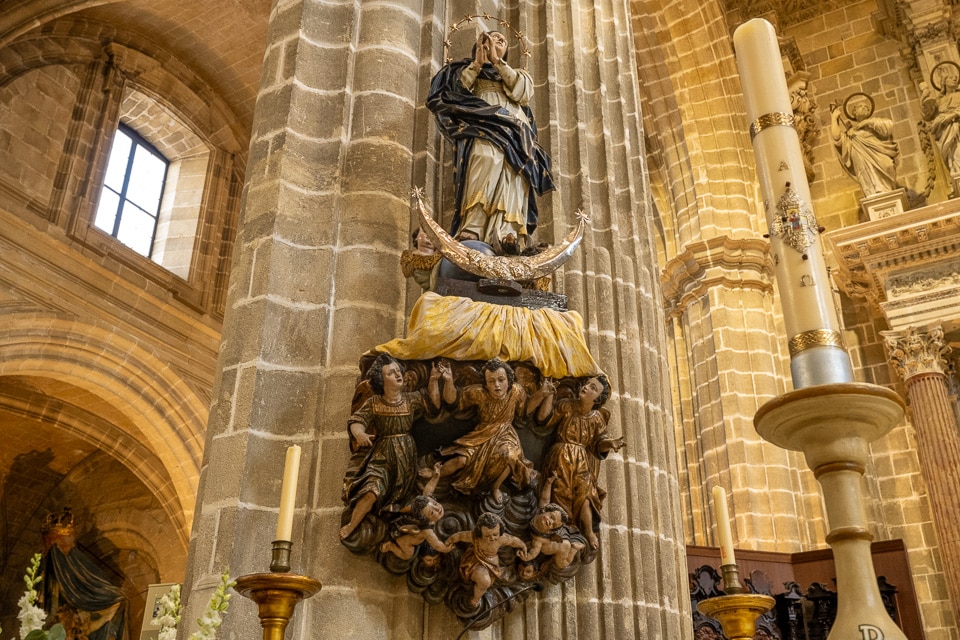
Alcázar of Jerez de la Frontera
The remains of the former Moorish castle cover a sizeable area of Jerez, near the Cathedral. While we didn’t enter during our visit, we know the alcázar contains not only walls, doors, and details of interest, but the only remaining mosque in Jerez, complete with minaret and courtyard.
Archeology Museum
To wander back to Roman times, visit the archeology museum housed in an 18th Century building of interest in its own right.
Jump to the City Scenes section below for more notes on interesting landmarks in Jerez.
Sherry
First thing to know is that the word ‘sherry’ is derived from the city’s early Arabic name, Sherish, from which the Old Spanish name Jerez (Hr-ETH) comes.
Sherry is this region's fortified wine, made from white grapes. Jerez has been the center of wine production since the Phoenicians introduced viniculture to the area around 1100 B.C. Once the Moors introduced distillation, the fortified wines – including brandy – grew steadily more popular. By the 18th Century, the bulk of sherry was exported to Great Britain, hence the ownership of many bodegas by United Kingdom families and companies. (You'll find the same is true of Portugal's port wines.)
By all means, visit a winemaker’s bodega to learn more. There are a couple dozen tours and tasting opportunities right in and around central Jerez at authentic sherry bodegas. Some are operated by the big dozen or so major companies: González Byass (Tio Pepe), Domecq (Fundador), Lustau, Grupo Estévez, Grupo Garvey as examples as examples of top wineries.
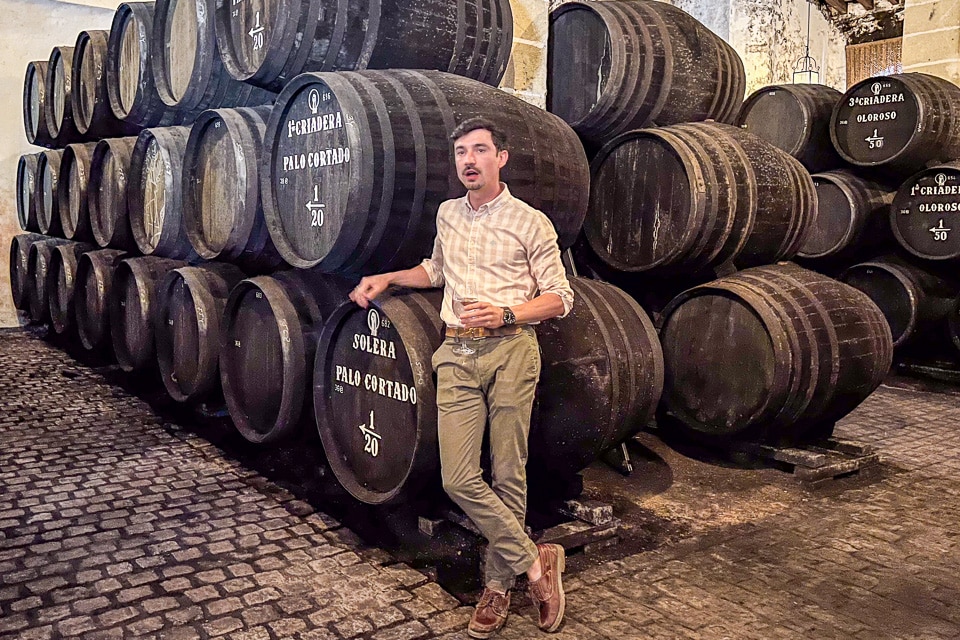
We chose to go with a smaller house for a sherry tasting. Valdespino was recommended to us. But I ended up visiting the nearby Bodegas Tradición by myself since Tom wasn’t feeling well. It was a bit of a splurge; €55 is quite a bit more than the standard tasting at an authentic sherry bodega, but worth it. Besides a great tour and explanation of the process, the tasting itself was a revelation. Some of the tasting notes below.
Along with the tasting at Tradición comes entrance to the family's private art collection. It’s an amazing exhibition including El Greco's painting of St. Francis of Assisi, a set of paintings of the Annunciation from three centuries of Spanish artists, and notable works by Velazques, Goya, Zuburan, Murcillo.
But, back to the sherry! Bodegas Tradición represents centuries and generations of winemakers, narrowing down to the Ribero family: Joaquin in the 1970s and Elena from the 1990s.
The focus at Bodegas Tradición is on VOS (20 year) and VORS (30+ year) products. Fino is always an exception to this sort of aging; it's life is limited to under 12 years for best quality. The three while grapes used for sherry are (dry to sweet) Palomino, Pedro Ximenez, and Moscatel.
After touring the facilities and gaining an understanding of the barrel process in the cathedal-style bodega, we sat outside in the leafy courtyard and tasted these sherry varieties:
Fino. 10 years old, dry, notes of honey. Pairs with olives, anchovies, jamón, fish, sushi. (Less than than 1 gram of sugar per liter; 9% alcohol.)
Amontillado. 30 years, VORS. Pairs with red tuna, asparagus, artichokes. (2 gram sugar per liter; 21% alcohol). Amontillado is sometimes dubbed mentiroso (liar) because it smells sweet but tastes dry. Complex, one of my favorites.
Oloroso Meaning aromatic. A dark varnish color. Lovely to sip or paired with cheese. (21.5% alcohol)
Palo Cortado This has the nose of Amontillado but tastes smooth like an Oloroso. The name, ‘cut stick' refers to the chalk notation on a barrel if the sherry has surpassed the defined yeast/alcohol level. It's then removed from the normal production process and bottled and sold separately, a rare potion worth a try if you see it's available.
Cream Tradición Cream Sherries are actually blends of dry and sweet varieties. (135 grams sugar per liter. 18% alcohol)
Pedro Ximenez Named for the grape, this sweet version of sherry is made by stopping the fermentation to keep alcohol low while the sugar climbs to 450 grams per liter. Still, this is not a cloying sweet wine, but intense and fresh.
N.B. Manzanilla, I learned, is from nearby San Luca, another point of the small ‘Sherry Triangle' to the west of Jerez. It’s essentially the same as Fino, but from a different place. When in Jerez, order Fino. When in San Luca, order Manzanilla.
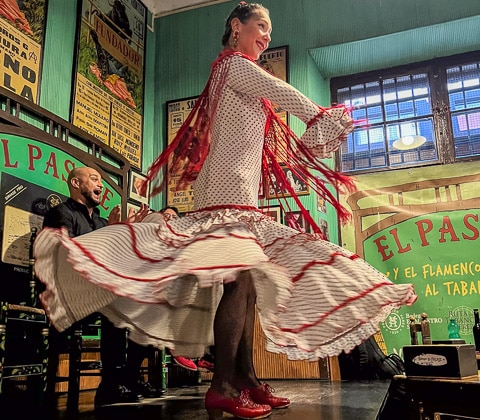
Flamenco
A handful of tablaos, places where Flamenco is performed, offer multiple Flamenco shows every night. You may be able to walk right into some venues without reservations. But better to book a table and enjoy the full experience. You may find yourselves, as we did, just a couple feet from the stage and served a set menu of tapas – jamón, cheese, artichokes with balsamic vinegar – with a bottle of fino sherry.
After failing to get a reservation at the first places I tried, I took the advice of our hotel staff. Rather than calling, I walked around in the afternoon and found a convenient place that looked good. I ended up booking the table for two from my phone while standing at the bar, helped by the friendly bartender. (The website and our conversation though, were entirely in Spanish. Ask you hotel concierge if you need help.)
We returned later for an excellent show at Tabanco El Pasaje, “vinos y flamenco de Jerez.” Tabanco, a word specific to the Jerez area, combines words for shop and tobacco, it's thought. At any rate Tabanco El Pasaje has been selling sherry since 1925. The flamenco shows came later.
Don’t worry about it too much. Go where you can and then go again the next night! A flamenco show – combining flamenco music, dance and vocals – usually runs under ninety minutes with intermission, and isn't expensive. We paid €30 per person for the combined ‘espectáculo', tapas, and drinks.
Around town take note of statues and pop-up memorials to Flamenco legends, like Lola Flores.
Horses
Without time to visit the equestrian center, I knew we were leaving Jerez with only a half-painted picture. I’ll take some consolation in having had a chance to see Lipizzaners, the dancing horses, at their other primo venue, Vienna, Austria, home of the Spanish Riding School.
In Jerez, horses have been a big deal for centuries. The Royal Andalusian School of Equestrian Art is one of the world’s premiere riding schools and includes a carriage museum. The Yeguada Militar de Jerez de la Frontera, known outside Spain as the Yeguada Militar, is basically the Spanish stud farm dedicated to the breeding of purebred Andalusian and Arabian horses since 1847.
Jerez is known for the Carthusian sub-strain of Andalusian horses, named for their protectors the Carthusian monks, who refused to breed the Andalusians with Napoleonic horses back in the day.
To get a dose of Spain’s equestrian heritage, do take in a horse show. It will be unlike anything you've ever witnessed and remind you of the strong equestrian tradition of Spain in general and Andalucía specifically. But if that doesn’t work for you, at least stop by the School mid-morning to catch a practice session.
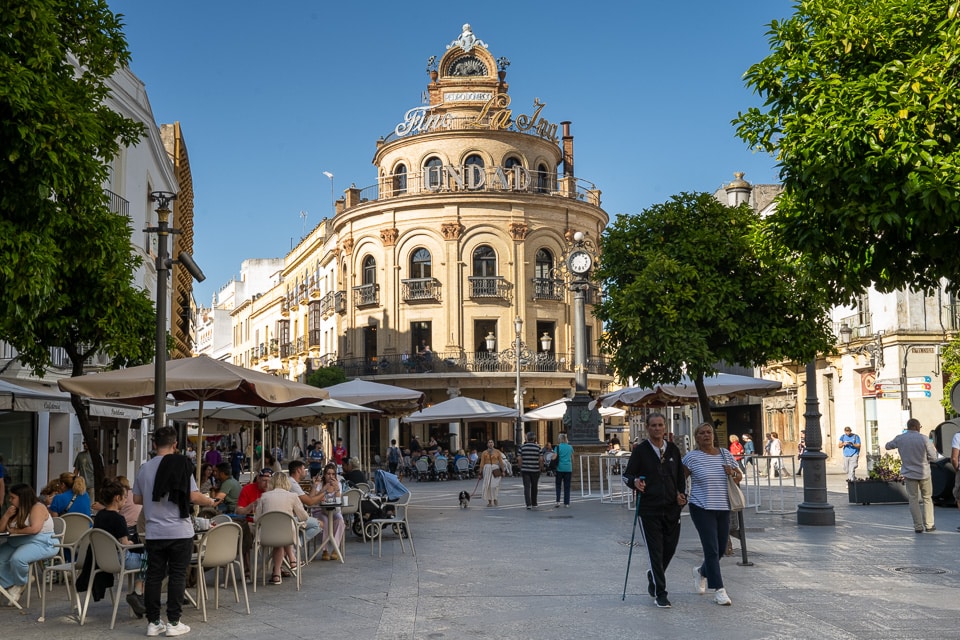
City Scenes and Landmarks
Allow time to wander. Jerez is a beautiful city to walk. In the center, narrow streets connect neighborhood churches, tiny plazas spotted with orange trees, myriad palaces and mansions with beautiful gardens decked with bougainvillea, shady corridors winding through bright white buildings.
As you start to feel comfortable, you’ll notice the city scenes are both idyllic and populated, historic and modern, and supported by small independent merchants as well as the big companies. Find the landmark clock tower (Reloj Domecq) at the base of the Calle Larga shopping street, and in front of the curved-front Domecq building. It's a great place to stop for a glass of sherry and some people watching.
Nearby is the Mercado Central de Abastos, a thriving market and showcase of local meat, fish, produce, and artisan goods. Fortunately, there's a Churrería just outside the door so you can get your pastry and sugar rush before you enter.
Throughout the heart of the old town, in every direction from the big Plaza del Arenal, shops and tapa bars propel pedestrians from one street to another.
Of course you can find top Spanish brands along popular shopping streets like Calle Larga. For souvenirs, if you want to carry back something other than bottles of sherry, look for other agricultural treats: exceptional olive oils, olive-based soaps, paprika, saffron, and more sherry.
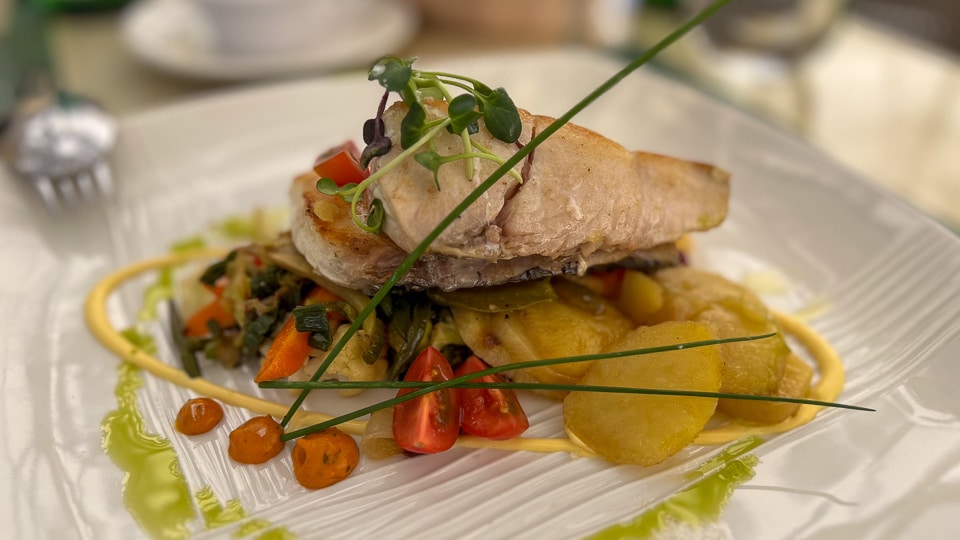
Where to Eat
Our favorite stops, with some recommendations from friends, include:
Bar Restaurante Albores. Our best meal in Jerez de la Frontera, based on Albores' creative menu, fresh local ingredients, presentation, and pleasant street-side seating. Check out the sister restaurant, A Mar, too, also by Chef Julián Olivares.
El Gallo Azul. In the iconic building with the big Fundador sign, this landmark is a backdrop to the city and an elegant place to stop for sherry, coffee, or a bite to eat.
Tasca del Flores. You may not want to traipse across town for this small wine bar, but as our local tapa joint, it was unbeatable. (Across from Hotel Palacio Garvey.)
Abacería Cruz Vieja. A classic tapas bar in a classic neighborhood. Now that you've learned something about sherry, sample away accompanied by a vast tapas menu. Check out the well visible under glass beside one end of the bar. The barkeeps can tell you stories!
Where to Stay
Hotel Palacio Garvey. Much less expensive than the Casa Palacio Maria Luisa mansion next door. But still a wonderful location and great service. (We appreciated extra help and concern when we inquired about a doctor and pharmacy.) Nice and easy breakfasts here are recommended. We loved the artwork (lots from Africa) and public spaces.
Casa Palacio María Luisa. A great example of a palace conversion and top notch hotel, catering to events and the sherry crowd.
Hotel Bodega Tio Pepe. Wedged between the Cathedral and the Alzàzar, this top hotel is known for its great restaurant and historic setting. But opt for a separate, more intimate, sherry bodega visit rather than the Tio Pepe tour.

When to Visit
Like all of Andalucía and Extremadura, Jerez can get really hot in the summer. Recent records have sent thermometers over 40 degrees Celsius (close to 110 F). But on average the summer highs are in the high 80s to low 90s F, and winter highs are in the high teens, low 20s C (high 60s and low 70s). The sweet moderate temperature months of March-April and October-November are naturally the busiest, too.
Big events in Jerez include the annual Feria del Caballo horse fair, Semana Santa, and the Spanish Motorcycle Gran Prix event in April. The last was just getting underway as we left town. Beer can be popular in Jerez, too!
How to Get to Jerez de la Frontera
Bus and train service from Sevilla is frequent and reliable, easy enough to make a day trip to Jerez from Sevilla.
In our case, we arrived by bus from Algeciras and departed by train to Mérida. The bus and train stations are adjacent. Though they are walkable to Jerez's city center, with luggage we opted for taxis to and from our hotel.
Up Your Travel Skills
Looking to book your next trip? Use these resources that are tried and tested by us. First, to get our best travel tips, sign up for our email newsletter. Then, be sure to start your reading with our Resources Page where we highlight all the great travel companies and products that we trust. Travel Accessories: Check out our list of all the accessories we carry to make getting there and being there a lot easier. Credit Cards: See our detailed post on how to choose the right travel rewards credit card for you. Flights: Start finding the very best flight deals by subscribing to Thrifty Traveler. Book your Hotel: Find the best prices on hotels with Booking.com. See all of the gear and books we like in one place on our Amazon shop.Got a comment on this post? Join the conversation on Facebook, Instagram, or Threads and share your thoughts!



